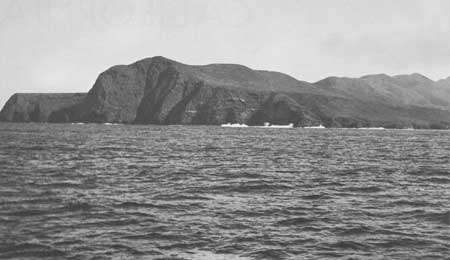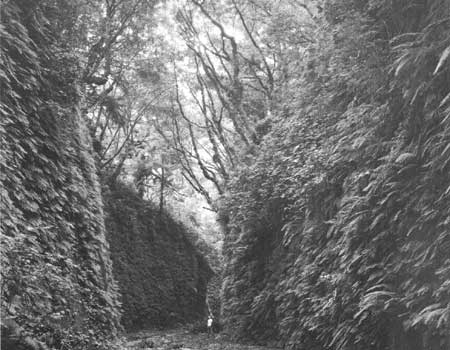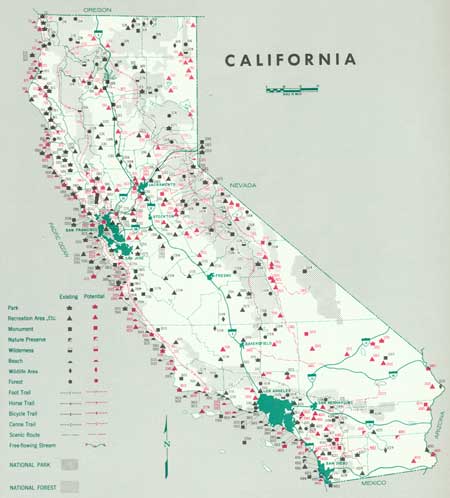.gif)
Parks for America
MENU
|
Parks for America
|

|

|
| Santa Cruz Island, Calif., one of the five northern Channel Islands. This group presents one of the finest opportunities in America to protect island, seashore, and related marine values in national seashore status. |
CALIFORNIA
CALIFORNIA'S wide range of natural resources from the Pacific coast to the High Sierra and the Colorado River desert provides great recreation opportunities for its residents and attracts many visitors.
The State population increased 48 percent in the last decade to 15,717,204 in 1960. It may soar to 23,744,000 by 1976. Eighty-six percent of the people live in urban areas. Although there were 100 people per square mile in the State, 9 counties had less than 5 persons per square mile in 1960.
Tourism is an important segment in California's economy with an estimated $920,890,000 outlay in 1960.
The State is building a freeway system designed to handle highway demand expected to triple by 1980. One of the objectives is to provide better access to major recreation regions. Air, rail, and water transportation are significant in bringing recreationists into California.
The basic recreation resources include hundreds of miles of varied seacoast, spectacular deserts, great mountain ranges, a salubrious climate, vast forests, including the world-renowned redwoods, wilderness areas, numerous rivers, mountain lakes and streams, and coastal boating areas, notably San Francisco Bay and the Sacramento Delta. Reservoirs offer growing opportunities for water-oriented recreation. Hunting and fishing (coastal, lake, and stream) are important recreation activities, and winter sports are assuming increasing significance.
There are many prehistoric sites and historic sites dating from the early Spanish days. Twenty-one sites possess exceptional value in commemorating the his tory of the United States.
EXISTING PUBLIC AREAS
NATIONAL: The National Park Service administers 4 national parks and 8 national monuments that contain 4,051,842 acres and had an attendance of 7,397,500 in 1960. The Forest Service manages 23 national forests totaling 20,599,438 acres on which are 18 areas of the wilderness type and 1,400 developed recreation areas. There are 13 national wildlife refuges with a total of 207,592 acres, administered by the Bureau of Sport Fisheries and Wildlife. The Corps of Engineers has 15 completed flood- and debris-control projects with varying degrees of recreation use and potential. Under the Bureau of Reclamation are 16 reservoirs with 313,000 acres of land and water. The Bureau of Land Management has set up six cooperative land and wildlife management areas.
STATE: The California Division of Beaches and Parks manages 695,900 acres in 188 parks, beaches, recreation, historic, and related areas. The 1960 attendance was 24,476,356. The California Division of Fish and Game has 18 wildlife management areas, with 188,780 acres. There are eight State forests, 70,225 acres, under the California Division of Forestry. Thirty-four designated waysides are maintained by the State Highway Commission. The State has about 200,000 acres of water usable for swimming and boating and approximately 500 boat-launching and mooring facilities. The California Hiking and Riding Trail, about half complete, will extend 1,900 miles through the Sierra and Coast Ranges.
LOCAL: Major areas identified in this plan include 4 parks, 26 recreation areas, and 1 beach. They are administered by county irrigation districts and regional park districts. Total acreage of these areas is 31,009 acres.
PRIVATE ENTERPRISE: Private enterprise assumes an important role in meeting resort demand and providing facilities on private and public lands. Recreation and tourist travel is largely accommodated by well-developed motel and trailer park systems. Public utility reservoirs also provide recreation outlets.
PARK AND RELATED NEEDS
National, State, and local agencies administer 5 million acres of park and recreation lands in California. Another 20 million acres are in national forest, wildlife refuge, and public domain status. This tremendous acreage gives California an excellent base for meeting the needs of the State's urban population and out-of-State visitors. There should be a general expansion of Federal, State, and local park and recreation areas and facilities. One urgent need is for close-in areas to preserve open space and provide for day and weekend recreation in the southern California, San Francisco Bay, and Sacramento urban areas. Land areas related to existing reservoirs are generally inadequate. California's farsighted scenic-route concept needs implementation and adequate local participation. Preservation of selected free-flowing streams and related values needs attention.
An adequate system of waysides, appropriately administered, is a serious need. Federal participation is needed to assure coast redwoods conservation commensurate with their international significance. Rapid acquisition is needed of the last remaining sections of Pacific coast shoreline possessing recreational values before urbanization spreads to all sections of the coast.
Potential State park, recreation, beach, and related lands identified in this plan total 535,079 acres. Potential local lands amount to 73,745 acres. If acquired, they will go far in meeting general expansion and specific needs.

|
| Fronds festoon the walls of Fern Canyon, a proposed addition to Prairie Creek Redwoods State Park, California. (MOULIN) |
RECOMMENDATIONS
Existing recreation resources and many potential areas are shown on the accompanying tabulation and map. The following recommendations are made to help provide needed outdoor recreation opportunities for public enjoyment and use.
NATIONAL: Early acquisition and development of Point Reyes National Seashore and establishment of a Channel Islands National Seashore. Further study of Coast Redwoods National Park potentialities, Old Mint National Monument, and the best means of developing the recreation potential of Whiskeytown and related reservoirs and surrounding scenic area in northern California.
STATE: Enlargement of the State park system to protect valuable park and beach resources and provide additional recreation opportunities by the addition of 12 parks, 23 recreation areas, 4 historic monuments, 3 nature preserves, and 12 beaches, with further study of 9 recreation areas, 4 scientific monuments, 3 historic monuments, 8 nature preserves, and 13 beaches. Designation and protection of 19 scenic roads and 7 free-flowing streams. Complete development of the California Hiking and Riding Trail.
LOCAL: Establishment of 5 parks, 37 recreation areas, 1 scientific monument, and 2 beaches.
Supporting recommendations include clarification and expansion of the highway wayside program.
(Table omitted from online edition)

|
| (click on image for an enlargement in a new window) |
NEXT >>>
|
|
Last Modified: Mon, Sep 6 2004 10:00:00 pm PDT
parks_america/california.htm
 Top
Top